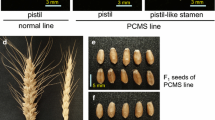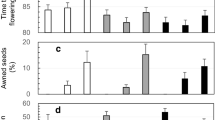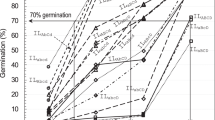Abstract
This study examined the nature of summer dormancy in E. scaber and reports on hybridisation attempts with a range of wheat genotypes to determine the suitability of E. scaber as a donor species in the development of ‘perennial wheat’. In a field experiment, E. scaber populations sourced from agro-ecologically diverse sites in south-eastern Australia, were subjected to three irrigation treatments to test their level of summer dormancy. The tillering reaction to opportunistic summer moisture was the same across all populations and suggests that summer dormancy is facultative in populations of E. scaber, rather than complete as previously reported. Using E. scaber as a pollen source, attempts were made to fertilise 16 wheat cultivars, used as emasculated female parents. Two rescue techniques were used to recover immature embryos at 24–48 h and 14 days post-pollination. Pollinated wheat spikes showed high proportions of early seed set, indicating fertilisation was taking place, however embryo recovery was very low. Several putative hybrid plants were recovered from both rescue techniques. PCR testing of the recovered plants was unable to detect E. scaber DNA and surviving plants were entirely like the wheat parent and fully fertile, suggesting either these plants were the result of rare self-pollination or doubled haploids following E. scaber chromosome elimination. The short lived nature of E. scaber along with challenges associated with crossing this species to wheat, has led the authors to conclude that E. scaber is not a priority candidate to be used as a perennial donor species in perennial grain development.





Similar content being viewed by others
References
Ahmad F, Comeau A (1991) Production, morphology, and cytogenetics of Triticum aestivum (L.) Thell × Elymus scabrus (R. Br.) Love intergeneric hybrids obtained by in ovulo embryo culture. Theor Appl Genet 81(6):833–839
Anamthawat-Jonsson K (1995) Wide-Hybrids between wheat and lymegrass: breeding and agricultural potential. Buvisindi 9:101–113
Annicchiarico P, Pecetti L, Bouzerzour H, Kallida R, Khedim A, Porqueddu C, Simoes NM, Volaire F, Lelievre F (2011) Adaptation of contrasting cocksfoot plant types to agricultural environments across the Mediterranean basin. Environ Exp Bot 74:82–89
Banks PM, Xu SJ, Wang RRC, Larkin PJ (1993) Varying chromosome composition of 56-chromosome wheat × Thinopyrum intermedium partial amphiploids. Genome 36(2):207–215. doi:10.1139/g93-029
Barclay IR (1975) High frequencies of haploid production in wheat (Triticum aestivum) by chromosome elimination. Nature 256(5516):410–411
Bell LW (2013) Economics and system applications for perennial grain crops in dryland farming systems in Australia. In: Batello C, Wade L, Cox S, Pogna N, Bozzini A, Choptiany J (eds) Perennial crops for food security. In: Proceedings of the FAO Expert Workshop, Rome, Italy, 2013. Food and Agriculture Organisation of the United Nations, pp 169–186
Bertin I, Fish L, Foote TN, Knight E, Snape J, Moore G (2009) Development of consistently crossable wheat genotypes for alien wheat gene transfer through fine-mapping of the Kr1 locus. Theor Appl Genet 119(8):1371–1381. doi:10.1007/s00122-009-1141-z
Bhamidimarri S, Saha MC, Payton ME, Hopkins AA (2012) Phenotyping summer dormancy in tall fescue. Crop Sci 52(1):413–421. doi:10.2135/cropsci2010.11.0660
Bureau of Meteorology Climate data online (2013) Commonwealth Of Australia. www.bom.gov.au/climate/data/. Accessed 29 Nov 2013
Clark S, Harris C (2009) Summer dormancy in australian perennial grasses: historical background, a simulation study, and current research. Crop Sci 49(6):2328–2334
Cole IA, Johnston WH (2006) Seed production of Australian native grass cultivars: an overview of current information and future research needs. Aust J Exp Agric 46(3):361–373. doi:10.1071/EA04107
Cox TS, Bender M, Picone C, Van Tassel DL (2002) Breeding perennial grain crops. Crit Rev Plant Sci 21(2):59
Cox TS, van Tassel DL, Cox CM, DeHaan LR (2010) Progress in breeding perennial grains. Crop Pasture Sci 61:513–521
Culvenor RA (2009) Breeding and use of summer-dormant grasses in southern australia, with special reference to phalaris. Crop Sci 49(6):2335–2346
Culvenor RA, Boschma SP (2005) Evaluation of phalaris (Phalaris aquatica L.) germplasm for persistence under grazing on the North-West Slopes, New South Wales. Aust J Agric Res 56(7):731–741. doi:10.1071/AR04300
Dewey DR (1984) The genomic system of classification as a guide to intergeneric hybridisation with the perennial Triticeae. In: Gustafson JP (ed) Gene manipulation in plant improvement. 16th Stadler genetics symposium. Plenum Press, New York
Franke R, Nestrowicz R, Senula A, Staat B (1992) Intergeneric hybrids between Triticum aestivum and wild Triticeae. Hereditas 116(3):225–231. doi:10.1111/j.1601-5223.1992.tb00146.x
Gamborg OL, Miller RA, Ojima K (1968) Nutrient requirements of suspension cultures of soybean root cells. Exp Cell Res 50:151–158
Gernand D, Rutten T, Varshney A, Rubtsova M, Prodanovic S, Brüß C, Kumlehn J, Matzk F, Houben A (2005) Uniparental chromosome elimination at mitosis and interphase in wheat and pearl millet crosses involves micronucleus formation, progressive heterochromatinization, and DNA fragmentation. Plant Cell 17(9):2431–2438
Glover JD, Culman SW, DuPont ST, Broussard W, Young L, Mangan ME, Mai JG, Crews TE, Dehaan LR, Buckley DH, Ferris H, Turner RE, Reynolds HL, Wyse DL (2010a) Harvested perennial grasslands provide ecological benchmarks for agricultural sustainability. (Special Issue: Harvested perennial grasslands: ecological models for farming’s perennial future). Agric Ecosyst Environ 137 (1/2):3–12
Glover JD, Reganold JP, Bell LW, Borevitz J, Brummer EC, Buckler ES, Cox CM, Cox TS, Crews TE, Culman SW, DeHaan LR, Eriksson D, Gill BS, Holland J, Hu F, Hulke BS, Ibrahim AMH, Jackson W, Jones SS, Murray SC, Paterson AH, Ploschuk E, Sacks EJ, Snapp S, Tao D, Van Tassel DL, Wade LJ, Wyse DL, Xu Y (2010b) Increased food and ecosystem security via perennial grains. Science 328 (5986):1638–1639. doi:10.1126/science.1188761
Han F, Liu B, Fedak G, Liu Z (2004) Genomic constitution and variation in five partial amphiploids of wheat—Thinopyrum intermedium as revealed by GISH, multicolor GISH and seed storage protein analysis. TAG Theor Appl Genet 109(5):1070–1076. doi:10.1007/s00122-004-1720-y
Hayes RC, Dear BS, Li GD, Virgona JM, Conyers MK, Hackney BF, Tidd J (2010) Perennial pastures for recharge control in temperate drought-prone environments. Part 1: productivity, persistence and herbage quality of key species. N Z. J Agric Res 53(4):283–302
Hayes RC, Newell MT, DeHaan LR, Murphy KM, Crane S, Norton MR, Wade LJ, Newberry M, Fahim M, Jones SS, Cox TS, Larkin PJ (2012) Perennial cereal crops: an initial evaluation of wheat derivatives. Field Crops Res 133:68–89. doi:10.1016/j.fcr.2012.03.014
Hoen K (1968) Summer dormancy in Phalaris tuberosa. Aust J Agric Res 19(2):227–239. doi:10.1071/AR9680227
Howes H, Sidhu P, Sharma J, Davies P (2003) Wheat double haploids: Wheat × Maize technique. SARDI Research Report Series SARDI, Adelaide
Inagaki MN, Tahir M (1992) Production of haploid wheat through intergeneric crosses. Hereditas 116(1–2):117–120. doi:10.1111/j.1601-5223.1992.tb00214.x
Isbell RF (1996) The australian soil classification. CSIRO, Melbourne
Jauhar P (2007) Meiotic restitution in wheat polyhaploids (amphihaploids): a potent evolutionary force. J Hered 98(2):188–193
Johnston WH, Mitchell ML, Koen TB, Mulham WE, Waterhouse DB (2001) LIGULE: an evaluation of indigenous perennial grasses for dryland salinity management in south-eastern Australia. 1. A base germplasm collection. Aust J Agric Res 52(3):343–350. doi:10.1071/AR99140
Jones TA, Zhang X-Y, Wang RR-C (1999) Genome characterization of Mt-2 perennial and Ok-906 annual wheat × intermediate wheatgrass hybrids. Crop Sci 39(4):1041–1043. doi:10.2135/cropsci1999.0011183X003900040013x
Kao K, Michayluk M (1975) Nutritional requirements for growth of Vicia hajastama cells and protoplasts at a very low population density in liquid media. Planta (Berl) 126:105–110
Kumlehn J, Schieder O, Lörz H (1997) In vitro development of wheat (Triticum aestivum L.) from zygote to plant via ovule culture. Plant Cell Reports 16(10):663–667. doi:10.1007/s002990050298
Kumlehn JJ, Nitzsche W (1996) Plant regeneration from ryegrass ovules cultivated on endosperm-derived feeder cells. Plant Cell Tissue Organ Cult 44(3):235–241
Larkin PJ, Newell MT, Hayes RC, Aktar J, Norton MR, Moroni SJ, Wade LJ (2014) Progress in developing perennial wheats for grain and grazing. Crop Pasture Sci. http://www.publish.csiro.au/paper/CP13330.htm
Laude HM (1953) The nature of summer dormancy in perennial grasses. Bot Gazette 114(3):284–292
Laurie DA, Bennett MD (1988) Cytological evidence for fertilization in hexaploid wheat × sorghum crosses. Plant Breed 100(2):73–82. doi:10.1111/j.1439-0523.1988.tb00220.x
Liu ZW, Wang RRC, Carman JG (1994) Hybrids and backcross progenies between wheat (Triticum aestivum L.) and apomictic Australian wheatgrass ( Elymus rectisetus (Nees in Lehm.) A. Love & Connor): karyotypic and genomic analyses. Theor Appl Genet 89(5):599–605
Lu B-R, von Bothmer R (1991) Production and cytogenetic analysis of the intergeneric hybrids between nine Elymus species and common wheat (Triticum aestivum L.). Euphytica 58(1):81–95. doi:10.1007/bf00035343
Ludlow MM (1989) Strategies of response to water stress. In: Kreeb KH, Richter H, Hinckly TM (eds) Structural and funtional responses to environmental stress: water shortage. SPB Academic Publishing, The Hague, pp 269–281
Malinowski DP, Zuo H, Kramp BA, Muir JP, Pinchak WE (2005) Obligatory summer-dormant cool-season perennial grasses for semiarid environments of the Southern Great Plains. Agron J 97(1):147–154
McWilliam JR (1968) The nature of the perennial response in Mediterranean grasses. II. Senescence, summer dormancy, and survival in Phalaris. Aust J Agric Res 19(3):397–409. doi:10.1071/AR9680397
McWilliam JR, Kramer PJ (1968) The nature of the perennial response in Mediterranean grasses. I. Water relations and summer survival in Phalaris. Aust J Agric Res 19(3):381–395. doi:10.1071/AR9680381
Mitchell ML, Koen TB, Johnston WH, Waterhouse DB (2001) LIGULE: an evaluation of indigenous perennial grasses for dryland salinity management in south-eastern Australia. 2. Field performance and the selection of promising ecotypes. Aust J Agric Res 52(3):351–365. doi:10.1071/AR99141
Mochida K, Tsujimoto H (2001) Production of wheat doubled haploids by pollination with job’s tears (Coix lachryma-jobi L.). J Hered 92(1):81–83. doi:10.1093/jhered/92.1.81
Mujeeb-Kazi A (1995) Intergeneric crosses: hybrid production and utilisation. In: Mujeeb-Kazi A, Hetttel GP (eds) Utilising wild grass biodiversity in wheat improvement: 15 years of wide cross research at CYMMT. Research report No.2. CYMMT, Mexico
Mujeeb-Kazi A (2006) Utilisation of genetic resources for bread wheat improvement. In: Singh RJ (ed) Genetic resources, chromosome engineering and crop improvement, vol 2. Taylor and Francis, Boca Raton
Mujeeb-Kazi A, Gul A, Rizwan S, Farooq M, Bux H, Ahmad I, Mirza JI, Delgado R, Rosas ACV (2007) Cytogenetics of intergeneric hybrids between durum wheat (Titicum turgidum L.) with Thinopyrum intermedium and sub-species Actum, Glaucum, Pulcherrimum, Trichophorum Varnense. Pak J Bot 39:1217–1227
Muranty H, Sourdille P, Bernard S, Bernard M (2002) Genetic characterization of spontaneous diploid androgenetic wheat and triticale plants. Plant Breed 121(6):470–474. doi:10.1046/j.1439-0523.2002.00759.x
Murphy KM, Carter A, Zemetra RS, Jones SS (2007) Karyotype and ideogram analyses of four wheatgrass cultivars for use in perennial wheat breeding. J Sustain Agric 31(1):137–149
NCBI National Centre for Biotechnology Information (2011). National Library of Medicine. http://www.plantnet.rbgstd.nsw.gov.au/. Accessed 2 July 2011
Norton MR, Lelievre F, Fukai S, Volaire F (2008) Measurement of summer dormancy in temperate perennial pasture grasses. Aust J Agric Res 59(6):498–509. doi:10.1071/AR07343
Norton MR, Lelievre F, Volaire F (2006a) Summer dormancy in Dactylis glomerata L.: the influence of season of sowing and a simulated mid-summer storm on two contrasting cultivars. Aust J Agric Res 57(5):565–575. doi:10.1071/AR05237
Norton MR, Lelièvre F, Volaire F (2012) Summer dormancy in Phalaris aquatica L., the influence of season of sowing and summer moisture regime on two contrasting cultivars. J Agron Crop Sci 198(1):1–13. doi:10.1111/j.1439-037X.2011.00482.x
Norton MR, Volaire F, Lelievre F (2006b) Summer dormancy in Festuca arundinacea Schreb.; the influence of season of sowing and a simulated mid-summer storm on two contrasting cultivars. Aust J Agric Res 57(12):1267–1277. doi:10.1071/AR06082
Oram RN (1983) Ecotypic Differentiation for Dormancy Levels in Oversummering Buds of Phalaris aquatica L. Bot Gazette 144(4):544–551
QIAGEN (2006) DNeasy plant handbook. QIAGEN, Hilden
QIAGEN (2008) HotStarTaq PCR handbook. QIAGEN, Hilden
Sadasivaiah RS, Orshinsky BR, Kozub GC (1999) Production of wheat haploids using anther culture and wheat × maize hybridization techniques. Cereal Res Commun 27(1–2):33–40
Sanford P, Whalley RDB, Garden DL, Norton MR, Waters CM, Smith AB, Mitchell ML, Kobelt E, Friend DA, Hall E, Auricht G (2005) Identification of superior native and introduced grasses for low-input pastures in temperate Australia. The Rangeland J 27 (1):55–71. doi:10.1071/RJ05005
Sharma HC (1995) How wide can a wide cross be? Euphytica 82(1):43–64. doi:10.1007/bf00028709
Sirkka A, Immonen T, Varughese G, Pfeiffer WH, Mujeeb-Kazi A (1993) Crossability of tetraploid and hexaploid wheats with ryes for primary triticale production. Euphytica 65(3):203–210. doi:10.1007/bf00023084
Sood S, Dhawan R, Singh K, Bains NS (2003) Development of novel chromosome doubling strategies for wheat × maize sysytem of wheat haploid production. Plant Breed 122:493–496
Thapa R, Kemp DR, Michalk DL, Badgery WB, Simmons AT (2011) Seedling recruitment of native perennial grasses within existing swards. Crop Pasture Sci 62(7):591–602. doi:10.1071/CP10212
Torabinejad J, Carman JG, Crane CF (1987) Morphology and genome analyses of interspecific hybrids of Elymus scabrus. Genome 29(1):150–155. doi:10.1139/g87-025
Torabinejad J, Mueller RJ (1993) Genome analysis of intergeneric hybrids of apomictic and sexual Australian Elymus species with wheat, barley and rye: implication for the transfer of apomixis to cereals. Theor Appl Genet 86(2–3):288–294
Turner NC (1986) Adaptation to water deficits: a changing perspective. Funct Plant Biol 13(1):175–190. doi:10.1071/PP9860175
Virgona JM, Bowcher A (2000) Effects of grazing interval on basal cover of four perennial grasses in a summer-dry environment. Aust J Exp Agric 40(2):299–311. doi:10.1071/EA98015
Volaire F, Barkaoui K, Nortton M (2014) Designing resilient and sustainable grasslands for a drier future: adaptive strategies, functional traits and biotic interactions. Euro J Agron 52:81–89
Volaire F, Norton M (2006) Summer dormancy in perennial temperate grasses. Ann Bot 98(5):927–933. doi:10.1093/aob/mcl195
Waters CM, Garden DL, Smith AB, Friend DA, Sanford P, Auricht GC (2005) Performance of native and introduced grasses for low-input pastures. 1. Survival and recruitment. Rangel J 27(1):23–39. doi:10.1071/RJ05001
Whalley RDB, Friend DA, Sanford P, Mitchell ML (2005) Evaluation of native and introduced grasses for low-input pastures in temperate Australia: rationale and scope. Rangel J 27(1):1–9. doi:10.1071/RJ05004
Acknowledgments
This work was financially supported through the Future Farm Industries CRC, NSW Department of Primary Industries and Charles Sturt University. Technical assistance provided by Miss Susan Langfield (NSW DPI) and Mrs Jenny Gibson (CSIRO) during the course of the study is also gratefully acknowledged.
Author information
Authors and Affiliations
Corresponding author
Electronic supplementary material
Below is the link to the electronic supplementary material.
Rights and permissions
About this article
Cite this article
Newell, M.T., Hayes, R.C., Virgona, J.M. et al. Summer dormancy in Elymus scaber and its hybridity with wheat. Euphytica 204, 535–556 (2015). https://doi.org/10.1007/s10681-014-1328-5
Received:
Accepted:
Published:
Issue Date:
DOI: https://doi.org/10.1007/s10681-014-1328-5




